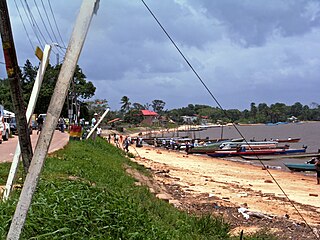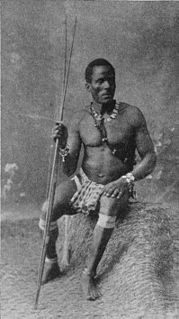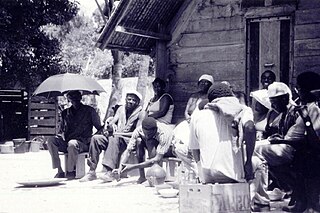
Marowijne is a district of Suriname, located on the north-east coast. Marowijne's capital city is Albina, with other towns including Moengo and Wanhatti. The district borders the Atlantic Ocean to the north, French Guiana to the east, the Surinamese district of Sipaliwini to the south, and the Surinamese districts of Commewijne and Para to the west.

The Saramaka, Saamaka or Saramacca are one of six Maroon peoples in the Republic of Suriname and one of the Maroon peoples in French Guiana. In 2007, the Saramaka won a ruling by the Inter-American Court for Human Rights supporting their land rights in Suriname for lands they have historically occupied, over national government claims. It was a landmark decision for indigenous peoples in the world. They have received compensation for damages and control this fund for their own development goals.

The Paramaccan or Paramaka are a Maroon tribe living in the forested interior of Suriname, mainly in the Pamacca resort, and the western border area of French Guiana. The Paramaccan signed a peace treaty in 1872 granting the tribe autonomy.

Albina is a town in eastern Suriname, and is capital of the Marowijne District. The town lies on the west bank of the Marowijne river, which forms the border with French Guiana, directly opposite the French Guianan town of Saint-Laurent-du-Maroni, to which it is connected by a frequent ferry service. Albina can be reached by bus via the East-West Link. The distance between Paramaribo and Albina is about 150 kilometres (95 mi).

Wanhatti is a village and resort in Suriname, located in the Marowijne district on the Cottica River. The resort is inhabited by the Ndyuka Maroons, and has a population of 468 people as of 2012. The village is primarily inhabited by Ndyuka of the Ansu clan or lo.

Gazon Matodya was gaanman of the Okanisi or Ndyuka people of Suriname, South America, one of six Maroon peoples in the area. He lived in Diitabiki (Drietabbetje), a village located on the Tapanahony River. Gaanman Gazon belonged to the Otoo Lo clan, from which most of the Aukan chiefs have come. He was one of the longest-living chiefs to date.

Tapanahoni is a resort in Suriname, located in the Sipaliwini District. Its population at the 2012 census was 13,808. Tapanahoni is a part of Sipaliwini which has no capital, but is directly governed from Paramaribo. Tapanahony is an enormous resort which encompasses a quarter of the country of Suriname. The most important town is Diitabiki which is the residence of the granman of the Ndyuka people since 1950, and the location of the oracle.

The Ndyuka people or Aukan people (Okanisi), are one of six Maroon peoples in the Republic of Suriname and one of the Maroon peoples in French Guiana. The Aukan or Ndyuka speak the Ndyuka language. They are subdivided into the Opu, who live upstream of the Tapanahony River in the Tapanahony resort of southeastern Suriname, and the Bilo, who live downstream of that river in Marowijne District

Ronnie Brunswijk is a Surinamese politician, businessman, footballer, convicted drug trafficker, former rebel leader, and the current Vice President of Suriname. Brunswijk served in the early 1980s as the personal bodyguard of Dési Bouterse, who overthrew the government in 1980 in a military coup. Brunswijk was discharged after asking for a raise, and denied back pay. In 1985, Brunswijk formed the Surinamese Liberation Army, better known as the Jungle Commando.
Van Velsen, Van Velzen, and Van Velze are Dutch toponymic surname referring to the town Velsen in North Holland. People with these surnames include:

Lantiwei, also spelled as Lantiwee and Lantiwé, is a Ndyuka Maroon village on the Cottica River in Suriname. Lantiwei lies opposite the village of Pinatjaimi, with Lantiwei being the village the people of Pinatjaimi originated from.

Pikin Santi, sometimes spelt as Pikien Santi, is a Ndyuka village on the Cottica River in Suriname inhabited by the Pinasi and Piika lo. Pikin Santi is situated upstream from Pinatjaimi and Lantiwei, and downstream from Tamarin. It lies in the vicinity of the Buku creek and should therefore be close to the ruins Fort Buku, which as of yet have not been identified.

Santigron is a Maroon village in Lelydorp, Suriname. The village of Santigron is along the Saramacca River not far from Paramaribo. It is one of Suriname's Maroon villages, where descendants of 18th Century run-away slaves live. Unlike in Brazil or Jamaica, some 20,000 Maroons are still living in Suriname 's rainforest and retain many aspects of their traditional Afro-American culture. The village was founded by Jajasie Adoemakeë in the middle of the 19th century. Adoemakeë started working at a nearby wood plantation, and claimed to received ownership after the plantation owner died in 1861, however the deed was lost.
Hendrik Ulbo Eric"Bonno"Thoden van Velzen was a Dutch anthropologist, Surinamist and Africanist.
Wilhelmina (Ineke) van Wetering was a Dutch anthropologist and Surinamist. She was born on 17 October 1934 in the Dutch city of Hilversum. When she was 10 years old, her father (ironmonger) had been executed by firing squad in the Second world war because of participating in an illegal group who provided hiding places for people who were prosecuted by the Nazi-German army. She finished her secondary school in 1955, when she began her study of sociology at the University of Amsterdam. In her later career she continued her work at the Vrije Universiteit Amsterdam.

Diitabiki is a Ndyuka village in the Sipaliwini District of Suriname. Diitabiki is the residence of the gaanman of the Ndyuka people, since 1950, and the location of the oracle.
The Lely Mountains are a mountain plateau on the left bank of the Tapanahony and Marowijne rivers in Suriname. The plateau has a maximum altitude of about 685 metres (2,247 ft). In 2005, 25 new species were discovered in the Lely Mountains.

Granman is the title of the paramount chief of a Maroon nation in Suriname and French Guiana. The Ndyuka, Saramaka, Matawai, Aluku, Paramaka and Kwinti nations all have a granman. The paramount chiefs of Amerindian peoples in Suriname are nowadays also often called granman.

Tebutop is a mountain in Suriname at 374 metres (1,227 ft). It is located in the Sipaliwini District.
Nason is a village of Paramacca Maroons in the Sipaliwini District of Suriname. The village is located on an island in the Marowijne River.















